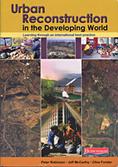sprawl ricerca ecological networks agriculture composition competition periodic news climate change call for papers technology representation populations social capital participation central places fabrication ecology adi governance urbanism fragile territories Communication city call for articles public policies
Urban Reconstruction in the Developing World
Learning through an international best practice
edited by Peter Robinson, Jeff McCarthy, Clive Forster
Urban Reconstruction in the Developing World offers a multi-disciplinary perspective on urban reconstruction and addresses several different audiences, namely: students of urban development disciplines; urban development practitioners; public, private and NGO sectors; and citizens, community leaders and development workers in developing countries.The case study that forms the basis of this book, the Cato Manor area of Durban in KwaZulu-Natal, South Africa, has been one of the most hotly contested urban localities in the history of South Africa. It is also an internationally acclaimed example of urban reconstruction, and has been conferred the status of International Best Practice by the United Nation's Commission on Human Settlements.
Urban Reconstruction provides an analysis of the following themes that have emerged internationally, and particularly in cities of the developing world:
• contested landscapes
• turning urban problems into solutions
• multi-disciplinary approaches to problem-solving with a view to achieveing integrated development outcomes
• managing complex, large-scale, urban development projects
• area-based urban development agencies and management
• establishing the pre-conditions for delivery at scale
• maintaining progress in continually shifting political and institutional environments.
"Urban development is destinated to be an importnat theme in the 21th century as over half the world's population lives in cities, rising to 61% by 2025. For this reason, it is in cities that the future quality of people's lives will be determined. Urban policy will thus assume increasing and crucial significance." (Hall & Pheiffer)
------------------------------------------------------------------------------------------------------------
CONTENTS:
Preface
List of Contributors
Abbreviations and Acronyms
Part one Introduction
• Issues in urban reconstruction
• Mega-projects and mini-projects
Part two History, politics and institutions - The context and foundations for urban development
• Historical and political context: Cato Manor, 1845-2002
• Socio-economics conditions in Cato Manor in the 1980s and 1990s
• Unfolding of the Project - Institutional and planning history of Cato Manor Development Project
• Spatial planning as a tool for integraton
• Urban development and land invasions
• Achievements of the Cato Manor Development Project
• Disjuncture between project design and realities on the ground
• Political interpretations
Part three Institutional dimensions of urban reconstruction
• Representation and governance
• Structuring for delivery: A separate legal institution with a public mandate
• Urban development partnership
• Learning from chameleons: Problem- solvers and problem- solving techniques
• Thriving on chaos and planning on the run: Management lessons and Cato Manor
• Approache to outsourching and procurement
• Efficiency in resource utilisation
Part four Developmental dimensions of urban reconstruction
• Poverty in Cato Manor: Perceived or actual?
• Sustainable livelihoods
• Public health challenges in an era of HIV/AIDS
• Gender and urban development in Cato Manor
• Community safety and public security
• Area-based local economic development
• Housing and in situ upgrading
• Land claims and conflict resolution
Part five Lessons for future urban development
• The rationale for area-based policies: Lessons from international experience
• Training for replicability
• A research method to generate knowledge
• Questions on an agenda for the next decade
------------------------------------------------------------------------------------------------------------




Planum
The Journal of Urbanism
ISSN 1723-0993
owned by
Istituto Nazionale di Urbanistica
published by
Planum Association
ISSN 1723-0993 | Registered at Court of Rome 4/12/2001, num. 514/2001
Web site realized by ChannelWeb & Planum Association | Powered by BEdita 3

